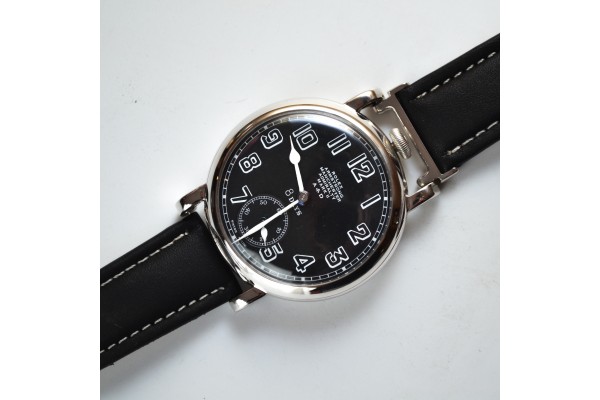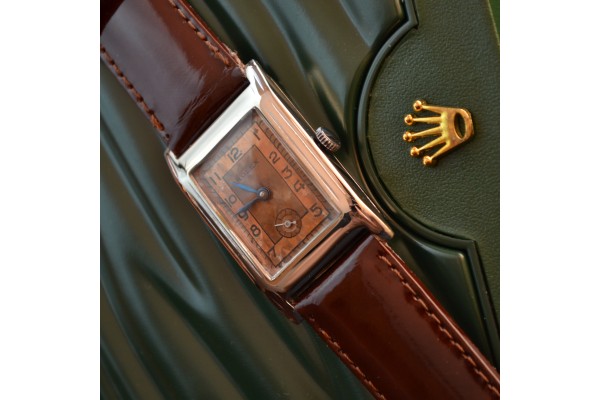ROLEX
The strange thing is that nobody knows how the name of the brand has appeared. The history of it is full of mystery and puzzles. There are a few guesses and theories about the origin of the combination of these letters. The first theory says that Rolex is the meaningless sequence of letters, which made up the beautifully-sounding name, which is easily pronounced in almost any language. Some people guessed that Rolex stands for the phrase “Horologerie exquise”, which means - contemporary watchmaking art. And according to the third theory, Rolex is the collection of letters that came to the mind of the famous watchmaker Hans Wilsdorf.
Now let's see how it all began ...
On the 22nd of March 1881, Mr Hans Wilsdorf, the founder of the Rolex Watch Company, was born. Sadly orphaned by the age of 12, he continued on with a full education at a leading boarding school in Switzerland and after leaving secured his first job as an apprentice in a large firm of pearl importers. However, it was due to friendship, struck while at school, that would see Mr Wilsdorf enter the world of watches. His friend turned to him one day and said:
"When we’re finished with all this school business, you’d better come and join us. We export watches all over the world"
So it was that Hans Wilsdorf, at an age of 19, started work as an English correspondent and clerk with the firm of Messrs. Cuno Korten in La Chaux-de-Fonds, Switzerland. His friend earlier comment had been no idle boast, as this firm was a very large exporter of watches with a turnover of nearly Frs1m a year. It was in this position that Mr Wilsdorf interest in watches was undoubtedly sparked. As he commented:
"... it provided an excellent opportunity to study the watch making industry closely and examine every type of watch produced both in Switzerland and abroad"
By 1903 Mr Wilsdorf had settled in London working for another watch making firm. After gaining experience from this and his previous employment and growing in self confidence he set about to established his own firm. With financial help from his brother-in-law, Alfred Davis, the company known as ‘Wilsdorf and Davis’ was founded.
In 1905 "Wilsdorf & Davis" began importing high-quality Swiss watch movements, produced by Hermann Aegler, and placing them in good-quality cases made by Dennison and others. These early watches were sold to jewelers who marketed them with their own names on the dial. The earliest known examples of Wilsdorf & Davis watches are signed "W&D" inside the case back. Contrary to popular belief, Wilsdorf was neither Swiss nor a watchmaker.
Wilsdorf was a German national, and Davis was British.The strange thing is thatame of the brand has appeared. The history of it is full of mystery and puzzles. There are a few guesses and theories about the origin of the combination of these letters. The first theory says that Rolex is the meaningless sequence of letters, which made up the beautifully-sounding name, which is easily pronounced in almost any language. Some people guessed that Rolex stands for the phrase “Horologerie exquise”, which means - contemporary watchmaking art. And according to the third theory, Rolex is the collection of letters that came to the mind of the famous watchmaker Hans Wilsdorf.
The "Rolex" trademark was registered in 1908, and the firm opened an office in La Chaux-de-Fonds, Switzerland, the world's center for high-quality watchmaking.
Wilsdorf as a young man, he stepped into the world of the Swiss watchmaking, when the world was completely ruled by pocket watches. Wilsdorf was sure that the future was for wrist watches. And although they weren't too precise that time,he foresaw that the watches could be can not only stylish, but also reliable. In order to convince his customers of the reliability of his innovative watches, Wilsdorf started to equip them with the small and very precise Swiss movements. The name Rolex was easily pronounced in all European languages and was short enough to fit the dial. The watchmakers of Rolex focused on the quality of the Rolex watch movements. Unrelieved struggle for the chronometric precise was soon crowned with success: in 1910, the Rolex watches became the first wrist watches, which received the official certificate from the Official Watch Rating Centre in Bienne. Four years later, Kew Observatory in Great Britain awarded the Rolex wristwatches a class “A” precision. Since that time, Rolex watches always associated with precision.
There is some debate as to the origins of the Rolex name. Wilsdorf was said to want an easily recognizable name that could be pronounced in any language and would fit easily on the dial of a watch. Some suggest that the name came from the French phrase horlogerie exquise, meaning "exquisite horology". J.P. Hess and James Dowling, in their bookThe Best of Time: Rolex Wristwatches, An Unauthorized History, clam that the name was just made up. "Rolex" was first registered as a company name on November 15, 1915. The Rolex name did not appear on the watch dial until 1926.
The strange thing is that nobody knows how the name of the brand has appeared. The history of it is full of mystery and puzzles. There are a few guesses and theories about the origin of the combination of these letters. The first theory says that Rolex is the meaningless sequence of letters, which made up the beautifully-sounding name, which is easily pronounced in almost any language. Some people guessed that Rolex stands for the phrase “Horologerie exquise”, which means - contemporary watchmaking art. And according to the third theory, Rolex is the collection of letters that came to the mind of the famous watchmaker Hans Wilsdorf.
Now let's see how it all began ...
On the 22nd of March 1881, Mr Hans Wilsdorf, the founder of the Rolex Watch Company, was born. Sadly orphaned by the age of 12, he continued on with a full education at a leading boarding school in Switzerland and after leaving secured his first job as an apprentice in a large firm of pearl importers. However, it was due to friendship, struck while at school, that would see Mr Wilsdorf enter the world of watches. His friend turned to him one day and said:
"When we’re finished with all this school business, you’d better come and join us. We export watches all over the world"
So it was that Hans Wilsdorf, at an age of 19, started work as an English correspondent and clerk with the firm of Messrs. Cuno Korten in La Chaux-de-Fonds, Switzerland. His friend earlier comment had been no idle boast, as this firm was a very large exporter of watches with a turnover of nearly Frs1m a year. It was in this position that Mr Wilsdorf interest in watches was undoubtedly sparked. As he commented:
"... it provided an excellent opportunity to study the watch making industry closely and examine every type of watch produced both in Switzerland and abroad"
By 1903 Mr Wilsdorf had settled in London working for another watch making firm. After gaining experience from this and his previous employment and growing in self confidence he set about to established his own firm. With financial help from his brother-in-law, Alfred Davis, the company known as ‘Wilsdorf and Davis’ was founded.
In 1905 "Wilsdorf & Davis" began importing high-quality Swiss watch movements, produced by Hermann Aegler, and placing them in good-quality cases made by Dennison and others. These early watches were sold to jewelers who marketed them with their own names on the dial. The earliest known examples of Wilsdorf & Davis watches are signed "W&D" inside the case back. Contrary to popular belief, Wilsdorf was neither Swiss nor a watchmaker.
Wilsdorf was a German national, and Davis was British.The strange thing is thatame of the brand has appeared. The history of it is full of mystery and puzzles. There are a few guesses and theories about the origin of the combination of these letters. The first theory says that Rolex is the meaningless sequence of letters, which made up the beautifully-sounding name, which is easily pronounced in almost any language. Some people guessed that Rolex stands for the phrase “Horologerie exquise”, which means - contemporary watchmaking art. And according to the third theory, Rolex is the collection of letters that came to the mind of the famous watchmaker Hans Wilsdorf.
The "Rolex" trademark was registered in 1908, and the firm opened an office in La Chaux-de-Fonds, Switzerland, the world's center for high-quality watchmaking.
Wilsdorf as a young man, he stepped into the world of the Swiss watchmaking, when the world was completely ruled by pocket watches. Wilsdorf was sure that the future was for wrist watches. And although they weren't too precise that time,he foresaw that the watches could be can not only stylish, but also reliable. In order to convince his customers of the reliability of his innovative watches, Wilsdorf started to equip them with the small and very precise Swiss movements. The name Rolex was easily pronounced in all European languages and was short enough to fit the dial. The watchmakers of Rolex focused on the quality of the Rolex watch movements. Unrelieved struggle for the chronometric precise was soon crowned with success: in 1910, the Rolex watches became the first wrist watches, which received the official certificate from the Official Watch Rating Centre in Bienne. Four years later, Kew Observatory in Great Britain awarded the Rolex wristwatches a class “A” precision. Since that time, Rolex watches always associated with precision.
There is some debate as to the origins of the Rolex name. Wilsdorf was said to want an easily recognizable name that could be pronounced in any language and would fit easily on the dial of a watch. Some suggest that the name came from the French phrase horlogerie exquise, meaning "exquisite horology". J.P. Hess and James Dowling, in their bookThe Best of Time: Rolex Wristwatches, An Unauthorized History, clam that the name was just made up. "Rolex" was first registered as a company name on November 15, 1915. The Rolex name did not appear on the watch dial until 1926.




